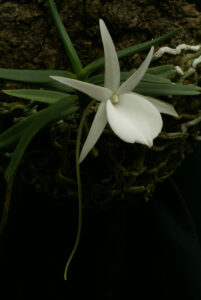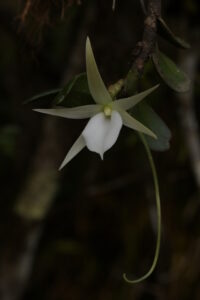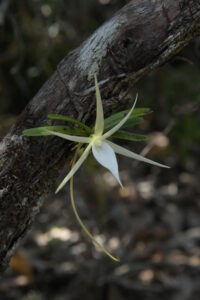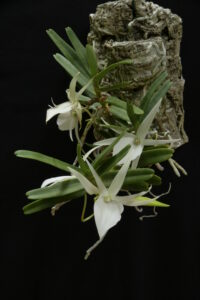The following article was written for the Orchid Species Bulletin published by the Orchid Species Society, which is based in Brisbane, Queensland in November 1999, and updated in November 2019.
Bear in mind that any cultivation notes refer to the subtropical conditions of Southern Queensland, Australia.
Angraecum rutenbergianum Kraenzl. was described by Fritz Kraenzlin in Abhandlungen des Naturwissenschaftlichen Vereins in Bremen in 1882. The specific epithet honours Christian Rutenberg, who was the first to collect this species in Madagascar.

Angraecum rutenbergianum
Angcm. rutenbergianum is placed in Angraecum section Perrierangraecum. Species belonging to this section have the inflorescence stalk covered entirely with 3-4 laterally compressed sheathing bracts; and large flowers, which have an ovary that is triangular in cross-section.
Seed-raised plants of Angcm. rutenbergianum have often been incorrectly labelled as Angcm. didieri or Angcm. elephantinum Schltr. Angcm. elephantinum is similar to Angcm. compactum Schltr. but that species has broader 2-2.5 cm wide leaves. In addition, the flowers of Angcm. compactum have narrower segments and lacks the wide entrance to the spur. Compared with Angcm. elephantinum, Angcm. didieri produces longer stems that bear shorter broader leaves and the blooms have narrower sepals, petals and labellum.

Angraecum didieri. Note the leaves are a different shape.
Angcm. rutenbergianum is a small monopodial lithophytic plant which can be quite variable . It produces short stems that are 1-2 cm tall but they may be 4-12 cm long on old mature plants. The stems are 6-7 mm in diameter and are mainly upright and often branch near the base. Its roots are very white and are distinctly very warty, with a green growing tip. The roots are produced along the stem to within 3-4 cm of the stem apex. There are 4-12 stiff, thick linear to strap-shaped rigid leaves that are 2-5.5 cm long and 5-7 mm broad, which are borne in two ranks. Single flowers are borne on short inflorescences, which pierce through the leaf sheath from nodes opposite the leaf base.

Angraecum elephantinum has narrower segments and a more acuminate lip.
The flower of Angcm. rutenbergianum is 5-6 cm wide and high and has a long (6-) 13.5-14 cm spur. Initially in the bud stage the spur is strongly coiled but straightens after opening. Colour of the flower is white with the sepals, petals and spur being slightly greenish on opening. A strong spicy fragrance is produced at sunset. Flowering is from mid-spring to mid-summer and the blooms last for about 3 weeks.
An epiphytic and lithophytic monopodial plant, Angcm. rutenbergianum is endemic to the humid evergreen forests of the east coast and the central highlands of Madagascar. It grows at moderate altitudes between 1,500-2,600 m altitude. During winter, the habitat is subject to cool and fairly dry conditions.

Angraecum rutenbergianum does well when cultivated on a mount.
Fred Hillerman and Arthur Holst (1986) have had good success by mounting this species on slabs. They say that it thrives in an intermediate greenhouse. Mounts are drenched almost daily and given good air movement. The recommended slab size is 10×20 cm, while a 7.5-10 cm pot is adequate. Angcm. rutenbergianum will bloom with low light intensities, however I recommend shading of approximately 70% as being suitable for growers in regions subject to strong sunlight – such as in south-east Queensland. In addition, I recommend a winter minimum of 10 oC. Plants can be kept a little drier during the cooler months while not actively growing, however it shouldn’t be allowed to remain dry for extended periods.
References:
Du Puy, D., Cribb, P., Bosser, J. & J. & C. Hermans. (1999) The Orchids of Madagascar. Royal Botanic Gardens, Kew.
Cribb, P.J. & J. Hermans. (2009) Field Guide to the Orchids of Madagascar. Kew Publishing, Royal Botanic Gardens, Kew.
Hermans, J. (2017) “The Angraecum Conundrums. “Lindleyana in Orchids, 86 (6):448-457.
Hillerman, F.E. & A.W. Holst (1986) An Introduction to the Cultivated Angraecoid Orchids of Madagascar. Timber Press, Portland, Oregon.
Stewart, J., Hermans, J. & B. Campbell. (2006) Angraecoid Orchids. Timber Press, Portland, Oregon.
